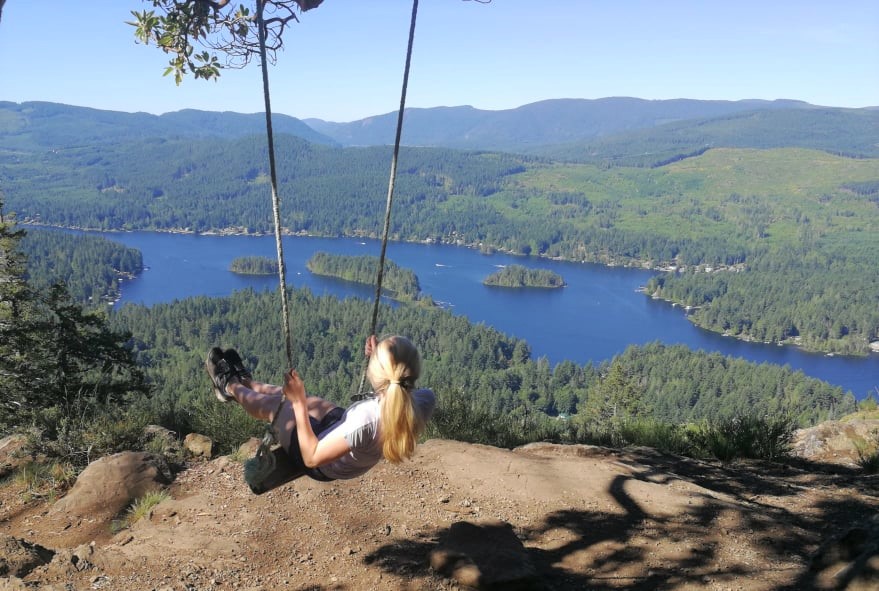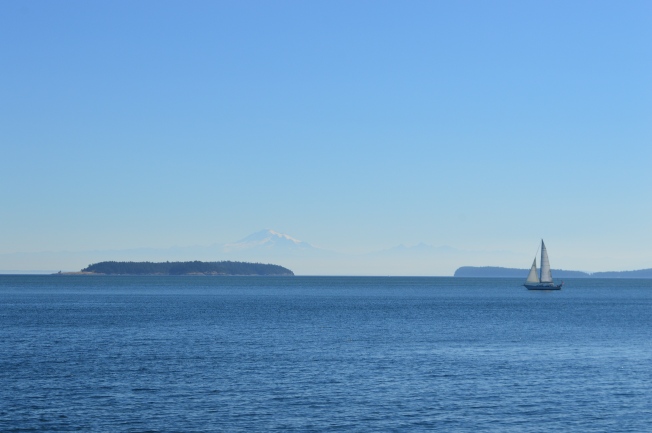If you’re spending time in Victoria on Vancouver Island and are looking for places to visit outside of the downtown hub, this guide is for you. For those that enjoy recreation and nature and don’t have a car, there are several interesting neighbourhoods to explore on foot outide of the city centre.
Located on the traditional Indigenous lands of the Songhees Nations, the localities of Gonzales, Oak Bay, and Uplands can all be considered affluent neighbourhoods. With leafy streets, pretty parks, ocean views, and sandy beaches, they are pleasant areas in which to unwind and enjoy island living.
Read on for ideas on how to spend 3 days in these picturesque neighbourhoods.
Day 1:
After enjoying a sleep-in, head to Good Earth Coffeehouse on Oak Bay Ave for a quick breakfast. It’s here that a friend introduced me to vanilla rooibos lattes. I’m not a huge tea drinker but these are delicious if you’re looking for something without caffeine.
After breakfast, walk down Foul Bay Road, admiring the grand houses and saying hello to the deer that can often be found snacking on someone’s lawn. At Crescent Road, cross the crosswalk and turn left. Shortly on the right, there’ll be a small parking area. Some stairs lead down to Gonzales Bay, a sandy beach that makes a good spot for an ocean dip and ball games. If you were to wake up and see this beach for the first time, you’d be forgiven for thinking you were in California. The sight of snow-capped mountains in the distance across the ocean will remind you that you’re further north! I recommend visiting Gonzales Bay on a weekday as it’s a very popular beach during summer weekends.

After you’ve had your fill of beach time, head back to Crescent Road and continue right. The road becomes King George Terrace as you walk up a hill that winds to the right. After a couple hundred metres, you’ll come to a rest area with parking spaces. If you feel like it, follow the path down to Trafalgar Park for a breezy view of the ocean.
From here, continue along King George Terrace as it winds downhill. Once the road flattens and it’s safe to do so, you’ll want to cross to the other side. Just next to the start of Sunny Lane is a narrow footpath that leads up to Walbran Park. The path involves a set of stairs and is quite a workout (not accessible for wheelchairs, sorry!) At the top, cross the road and follow a path to the viewing platform. The panoramic vista that includes views of the San Juan Islands of the US will be worth the thigh burn from the stairs!

If you feel like returning here during your trip, Walbran Park is an excellent spot to watch a sunset!
From this park, you can continue onto another nice viewpoint by walking left along Denison Road. After a few hundred metres, you’ll come to the entrance of Gonzales Hill Regional Park. Home to a striking white observatory, there are great views of glittering ocean, the leafy neighbourhoods of Fairfield and James Bay, the Westshore communities, and distant mountains of Sooke.

After all that walking, it’s time for a break and some cake! Exit Gonzales Hill via the path down Fairfield Place and, once on Fairfield Road, cross and walk down towards Foul Bay Road. On the right you’ll see an entrance to the Abhkazi Gardens, open everyday 11am-5pm with entry by donation. While they don’t have the same size and splendour as the world-renowned Butchart Gardens, these gardens are a lovely, tranquil place to wander through, without large crowds and the constant click of cameras. You might even see the small turtles by the pond!
The Teahouse within the gardens offers a few different menu options for high tea, provided in a cozy and non-pretentious setting. I had the afternoon tea last year and it was delicious! The final tea sitting is at 4pm. (Note that there is a dress code.)
Day 2:
Start your day by stopping at Demitasse Cafe & Garden Centre on McNeill Ave. As well as selling plants, this sweet little cafe has yummy savoury and sweet pastries, including gluten-free options. The double-baked almond croissant is one of my favourites. Fun fact: if you read my book, this cafe is featured a few times in part 3!
From the cafe, walk south down Hampshire Road, turn left on Lafayette St, and then turn right down Monterey Ave. The road will lead you to Beach Drive with McNeill Bay in front of you. This wide pebble beach is popular with dog walkers, but not so popular for swimming due to the prevalance of seaweed and fairly choppy waves.
Walk along the esplanade before turning left up Transit Road. After a hundred metres or so, there’ll be a sign on the right indicating the Centennial Trail. Follow the narrow path that’s cloaked by trees and you’ll come to Anderson Hill Park. Looking over NcNeill Bay, it’s a good place to sit and eat your almond croissant!

Go back the way you came down Transit Road until you return to Beach Drive. Cyclists will often pass by (some panting more than others!) as the road winds uphill to the right. At a rest area, you’ll see a small pebble beach below and some rocky bluffs with a few wooden chairs on top. This area is called Kitty Islet. Follow the path down and take a seat to enjoy a couple chapters of a book or watch the boats go by.

Once you’re ready to move again, continue along Beach Drive. Soon you’ll be surrounded by the neatly manicured lawns of Victoria Golf Club. Enjoy the ocean and mountain views as you walk – just keep an eye out for flying golf balls!
Beyond the golf course, you’ll eventually pass Oak Bay Beach Hotel, popular for it Boathouse Spa. A few years ago, some coworkers kindly gave me a gift card which I used to book a massage. At the time, guests received complimentary access to the sauna and mineral pools after their treatment. Now you have to pay an additional $30 to access them. If you have the cash to splash, I recommend booking yourself an appointment for a true self-care treat. Alternatively, you could stop for some lunch in the Hotel’s Faro restaurant, which specializes in Neopolitan-style pizzas.
Continuing along Beach Drive, the interestingly named Turkey Head Walkway is by Oak Bay Marina. Seals can often be seen swimming by the shoreline. Around here, you can book a fishing charter or rent a kayak or canoe to explore the calm surrounding waters. A little further along is Queen’s Park – a pretty, grassy park good for picnics, reading, or just enjoying the view of boats bobbing up and down.

When you continue along Beach Drive, you’ll pass a shallow bay and then see Haynes Park on your right. Turn left up the crosswalk away from the park and follow the path that goes up some steps and joins Oak Bay Ave. This bustling main street has many businesses to keep you entertained – a chocolate shop, florist, garden centre, art shop, bike shop, and fashion boutique to name a few. You’ll often see retired locals sitting with their dogs outside a coffee shop, chatting away. Popular dinner options include the Penny Farthing Pub, Vis-a-Vis, Bon Sushi, Deadbeetz Burgers, and Tapas on Oak.
On the second Wednesday during the summer months, the Avenue comes alive with Oak Bay Night Market. Live musicians play as local vendors sell crafts, jewellery, art, jams, honey, cheese, and more. A barbecue sizzles and food trucks sells various dishes, from Greek wraps to poutine to curries.
Day 3:
Grab a beverage and breakfast item to-go from Pure Vanilla Bakery on Cadboro Bay Road, or alternatively, sit down for a meal at The Village restaurant on Estevan Ave. I haven’t eaten at The Village myself, but everyone I know that’s eaten here has said good things.
Continue down Estevan Ave and the sight of sparkling water will come into view. This is Willows Beach, one of Victoria’s most popular places for sunbathing, picnics, paddleboarding, and an ocean dip. Runners will often jog along the esplanade and on an evening, seals might pop their heads up out of the water curiously. On a clear day, Washington’s Olympic Mountains rise up formidably in the distant west. The beach area also has a playground and public washrooms. Dogs are not permitted on Willows Beach between May 1st and September 30th. If you visit outside of this season, you can enjoy the sight of dogs galloping gleefully along the sand, making furry friends.
After catching some rays and having a splash, wander east along the espalanade and walk up the stairs. Following the path to the right takes you to Cattle Point. Where does this name come from, I hear you ask. Well, during the late 19th Century and early 20th Century, this area was the destination for unloading cows from steamships, and the cows would swim a short distance to shore (a funny image to picture, I know!) No cows are unloaded today and instead there is a boat launch. The east side of Cattle Point looks out towards Cadboro Bay, the next neighbourhood along. On a clear day, you’ll get a striking view of Mt. Baker in Washington State.
Willows Beach and Cattle Point are pretty places to visit during the evening, with the sky turning a soft lilac as the sun goes down. They are regularly featured in my book!

Cattle Point is part of Uplands Park. If you follow the loop round until you rejoin Beach Drive, across the road you’ll find an entrance to the main section of the park. It’s a peaceful oasis with various flat trails through Garry Oak meadow. Whenever I come here, I think it would be a great location for an engagement shoot or wedding photos.
For lunch, walk back along Beach Drive with its million-dollar houses and turn right back up Estevan Ave. Willows Galley is a family-run fish and chip shop open 12pm-6pm except Mondays and Tuesdays. As someone who comes from the country of fish and chips, I can confidently say I approve! The menu also includes burgers, poutine, and ice cream. Just up the road past Musgrave St is Lokier Garden, a quiet setting in which to enjoy your meal.
Within Estevan Village there is a florist, jewellers, barber shop, women’s gym, and clothing consignment store. You’re bound to see customers outside the popular Ruth and Dean bakery and cake shop, and near here is Bungalow gift shop which sells a variety of items including home decor, stuffed toys, soaps, and cards.
When it comes to dinner plans, Nohra Thai Kitchen on Estevan Ave has excellent reviews, as does the nearby Taiwanese restaurant AsUsual Cafe. Another option is the fancy farm-to-table restaurant Sedona, on Cadboro Bay Rod. Otherwise, The Old Farm Market on this road has a good selection of local products if you’d like to make your own dinner.
*
If you’re planning a trip to Victoria, I hope you’ll give yourself a few days to explore some of the neighbourhoods outside of the downtown core. I’ve lived in or around Oak Bay for most of the years I’ve lived in Canada, and the places I’ve mentioned in this post never lose their charm. If you like going for walks and finding scenic views, you’ll love exploring these areas!
GPSMyCity is an app that adds GPS coordinates to blog posts so you can access your favourite travel guides from your iOS or Android device, with a map included to help you navigate your way around. If you have a trip to Oak Bay planned and would like to reference this article, follow this link to download : https://www.gpsmycity.com/gps-tour-guides/victoria-4511.html












































